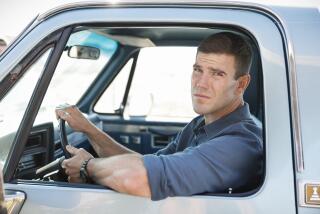‘CSI: Miami’ spells success with a capital ‘H’
It’s a crime procedural with the intensity of an action cop show whose lead investigators dabble Q-tips, recover hair strands, dive in the ocean for bodies, occasionally shoot their guns, drive SUVs through explosions, and push civilians out of harm’s way when a tsunami washes over the city.
They are pretty people and they dress the part, whether a bridge collapses, the Florida Everglades burn down, or they are standing next to a cadaver observing its autopsy.
It’s CSI: Miami-style.
The middle child of CBS’ “CSI” franchise is proving to be as hot as its tropical setting. With an average 19.5 million viewers tuning in every week, the series ranks sixth among prime-time shows and ninth among viewers who are 18 to 49 years old, the demographic advertisers covet.The show, now in its third season, is actually growing. Its total audience is up 11% from last year, and the 18-to-49 demographic is up by 18%.
This in a television season in which non-crime dramas, such as ABC’s runaway hits “Desperate Housewives” and “Lost,” have captured much of the media attention, and the “CSI” franchise debuted a second spinoff, “CSI: NY,” starring Gary Sinise and Melina Kanakaredes.
In fact, no matter what competitors put up against it, “CSI: Miami” has maintained its strength in the Monday 10 p.m. slot. NBC’s “Medium,” a new series about a woman who claims she can communicate with the dead, has scored impressive ratings but hasn’t put a dent in “Miami’s” audience. This season, producers have rewarded its loyal followers with a couple of action-filled 90-minute episodes; the next one, set in the Everglades, airs Feb. 21.
Like its siblings, “CSI: Miami,” revolves around the world of forensics and relies on computer-generated close-ups to zoom into body cavities and race along arteries, leaving a distinct if uncomfortable impression of the heinous manner a person has died.
“Our challenge was to find our own signature and distinguish ourselves a little bit and to capture some of what Miami is,” said David Caruso, the show’s star, during a recent interview in his trailer in Hawthorne, where the police department sequences are shot.
“There’s a cool about Miami. It’s vibrant, it’s colorful and there’s the heat, obviously. There’s a relaxed kind of approach to things. With this new world of forensic science set in this tropical environment, we think it’s a fairly effective combination.”
Apparently, so do its viewers, most of whom are women.
Week after week, 11.6 million female and 7.9 million male viewers are drawn to the serious and compassionate Horatio Caine, the lieutenant in charge of the Miami crime scene investigation unit, played by the red-headed Caruso, who relies on gumption and his gun to get the job done. Campy and melodramatic, he lets the bad guys know that he takes all crimes personally.
“If you’re going to take advantage of the weak, or you’re going to decide to destroy another person’s life -- or destroy a family -- I try to let them know inside that finite scientific process how I feel about them and how I think they should be feeling,” Caruso said.
The actor has been intricately involved with the development of Horatio’s character, beginning with the high-noon stance, then his slow and deliberate diction, and later even the wardrobe by using his own silhouette sunglasses.
As the team leader, “H” (his nickname on the show) always delivers a zinger, hands on his hips, sunglasses perched on his nose, as he basks in the Miami light seconds before the show’s opening sequence and theme song, “Won’t Get Fooled Again,” by the Who, starts thumping.
Science prevails in Las Vegas and New York, where Gil Grissom (William Petersen) and Mac Taylor (Sinise), respectively, are as diligent as Horatio Caine in solving cases. But they are less prone to check in on victims and their relatives or to make promises to suspects that they will be caught.
CBS President of Entertainment Nina Tassler says she thinks Horatio’s popularity with viewers lies with his sense of vindication for the victim. “It does inform the storytelling, and his team feels that same drive. They not only feel it because their boss needs it, but also because it’s the right thing to do, because he’s a righteous man,” Tassler said.
“When that line comes out of his mouth, you believe it.”
In the episode that introduced the “CSI: NY” cast, chief medical examiner Dr. Alexx Woods (Khandi Alexander) observes that a suspect who decapitated a woman “is a monster or he doesn’t know his own strength.” Before the music is queued for the show’s title opening, Caine responds: “Well, he’s about to know ours.”
When an assassin on a speedboat shoots up a party at an oceanfront home, Caine, facing the pink horizon, sums it up wryly: “Drive-by, Miami style.”
But the world of forensic science is not one Caine can tackle alone. He needs the soulful medical examiner who talks to dead bodies, Woods; beautiful ballistics expert Calleigh Duquesne (Emily Procter); lovable underwater recovery specialist Eric Delko (Adam Rodriguez); and this season’s addition, a very green but big-hearted geneticist, Ryan Wolfe (Jonathan Togo), whom Ann Donahue, the show’s co-creator and show-runner, compares to Dustin Hoffman in “The Graduate.”
“For us being a spinoff, initially we were trying so hard to be like the other one,” said Procter during a short break from a scene for the Valentine’s Day episode. “Maybe now our relationships with each other have congealed to a point on the show that we have a camaraderie that’s very genuine and viewers are responding to that.” Then why would the show’s creators pull a fast one in the third-season premiere and kill off popular character Tim Speedle, the cocky investigator with the street credibility? Actor Rory Cochrane actually opted to leave the show to pursue a film career, but it was Donahue’s pen that aimed a suspect’s gun in his direction, killing him in the line of duty.
“Our job is to entertain you, so if you hear that a beloved character is leaving, you don’t want him to sneak out,” said Donahue. “We wanted to send him off in a heroic way.”
Perhaps nobody misses him more than Rodriguez, who shared plenty of brotherly scenes with Cochrane in the first two seasons.
“We were always trying to one-up each other and we were constantly making jokes and kind of cracking on each other,” Rodriguez said. “I thought that brought a lot of levity to the seriousness of the science. I miss having that.”
But writer-producer Ildy Modrovich thinks the killing of Speedle’s character showed that the procedural series is willing to take risks. “We try really hard to remain true to what it is to be a cop,” she said. “I can’t imagine what that would be like if, all of a sudden, the office next to you was empty.”
That office, the one occupied by America’s civil servants, is one that Caruso respects so much it is not easy to distinguish when he speaks for himself or his character:
“That concept of protecting the quality of somebody else’s life, somebody you’ll never meet, is fascinating to me. It’s incredibly important to maintain reverence to the setting” when a victim is shown slain on television, he said.
“When we as a team come into your life, the most important thing we can provide to you is a sense of safety.”
The producers also try to provide scientific integrity, although that’s not completely possible. In crime labs across the country, it can take days or weeks to get DNA test results. In the “CSI” franchise, they’re available within the hour.
The sets include pricey equipment -- spectrometers, genetic analyzers, ViewSonic computer monitors and plasma TV screens that real crime scene investigators only wish their departments could afford. On all three “CSI” shows, the actors spend a lot of time alone with their fancy gadgets.
“Sometimes I feel like, man, I’m always acting with a Q-tip in my hand or a flashlight or DNA or whatever it is,” Rodriguez said. “You have to find the exciting part of the case, what makes your character interested in the case, because you’re repeating things that you do all of the time.”
Caruso, who is both famous and infamous for his “NYPD Blue” role as Det. John Kelly, appreciates the different discipline that playing a scientific cop affords him.
“In a normal dramatic setting, you’re allowed to give in to your emotions, you’re allowed to indulge yourself,” Caruso said.
“And that can be fascinating and great to watch when you see a great scene happen. But we don’t have that luxury because we’re inside a scientific process. Well, the fun thing about that as a performer is that you have to find a way to lace your humanity into that process, and to communicate who you are, what you’re thinking and feeling inside that scientific process. It has to be subtly realized and that can be much harder to do.”
Nothing has been tougher for Caruso than recovering from his hugely public debacle: storming off the set of “NYPD Blue” in 1994, after winning a Golden Globe in the first season, for what he thought would be greener -- as in dollars -- pastures. Armed with an offer of $1 million for “Kiss of Death,” he figured his career would only get bigger. It didn’t. His first attempt to return to television in 1997, playing the title role on CBS’ “Michael Hayes,” lasted only a season.
Then, while working on a Showtime movie, “Gold Coast,” Caruso “was seduced by Miami,” so he bought a condo and set up house with his third wife on South Beach in 1998. Little did he know that four years later he would be returning to Los Angeles to star in a criminal investigations show based in his new hometown. Nor could he have imagined that the industry and audience he abandoned would support him the way it has.
Three years after helping to turn “CSI” into a monster franchise, a humbled Caruso says he is grateful that the show’s producers and Viacom Co-Chairman Leslie Moonves, who oversees the CBS television network, selected him as Horatio Caine.
“I was tremendously inexperienced at the time and I was overwhelmed by the situation,” Caruso said, referring to his tempestuous departure from “NYPD Blue.” “The fact that they were willing to resurrect me has gone a great distance in giving me credibility again.
“I will play Horatio Caine as long as he continues to exist,” he said. “He is a man who ... has developed a certain amount of poise and great respect for how fragile we are as human beings. I can relate.”
More to Read
The complete guide to home viewing
Get Screen Gab for everything about the TV shows and streaming movies everyone’s talking about.
You may occasionally receive promotional content from the Los Angeles Times.






